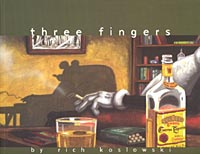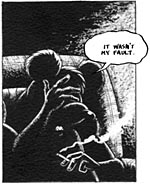
 Writer/Artist: Rich Koslowski
Writer/Artist: Rich Koslowski
Price: $14.95
Publisher: Top Shelf
ISBN: 1-891830-31-7
A horrible realization for me as a child was that cartoon characters weren't real. Even after I'd grasped the concept of fiction and actors, I assumed that, given all the commercials they appeared in, the cartoons had to be out in the real world, somewhere. It was a crushing blow to my psyche when, at the age of four, I was informed that yes, they were just drawings, and no, the Trix Bunny wasn't really allowed to have all the cereal he wanted when the cameras stopped rolling.
WHO FRAMED ROGER RABBIT only made things worse.
And now Rich Koslowski has come along with THREE FINGERS, and the old traumas are re-emerging...
The cartoons in THREE FINGERS, you see, are real. There are only two things separating you from the characters you love and remember. The first is that the names have been changed ever so slightly to protect the innocent, or at least the copyrights. The second is...well, time has not been kind to these people.
Not kind at all.
In "our" world, Mickey Mouse is still as fresh-faced and high-voiced as he was in the "Steamboat Willie" days. Here, Rickey Rat is...well, we can't really see. He's left in shadow, and judging by the chronic cough and beer belly, it's probably for the best.
The toons we do see are a virtual parade of lives ruined by beer, drugs and smoke; if you think the shriveled visage of rooster Carhorn Armwhistle is bad, wait till you see Portly Pig or Friedrich Von Katze. Or Dapper Duck. You'll have a difficult time keeping yourself from looking away when you see Dapper Duck.
 As you may have gathered, THREE FINGERS is not exactly a straightforward laugh riot. Well, there are laughs, but they're the nervous kind. The kind you have when something bad-but-funny happens to someone you don't know, and you laugh before you realize what it must have been like for the victim.
As you may have gathered, THREE FINGERS is not exactly a straightforward laugh riot. Well, there are laughs, but they're the nervous kind. The kind you have when something bad-but-funny happens to someone you don't know, and you laugh before you realize what it must have been like for the victim.
THREE FINGERS takes that logic and applies it to cartoons. You may have laughed when it happened, but it sure as hell wasn't funny to Wile E Coyote when he got crushed by that rock. The narrative takes the form of a documentary concerning the rise of toons in Hollywood, as told by an unseen narrator and scores of interviews with former cartoon stars. Lurking behind it all is Dizzy Walters, an ambitious young man who discovered Rickey Rat playing piano one night in Toonsville, and in the process created a new kind of cinema.
Success came easily for Rickey, and toons flocked to Hollywood. Except they had trouble replicating Rickey's success. Couldn't figure out how to do it. Until they noticed something they hadn't before. And that's when it all began...
The most insidious thing about THREE FINGERS is that in the terms of its own twisted universe, everything makes sense. Aficionados of Hollywood lore will see countless real-life events echoed here; the changed names, the theater stars who couldn't cross over, the surgery, the sex scandals, the ones who got out okay and look down on those that didn't, and the ones who can barely look back at all. And at the heart of it all remain two figures: Dizzy Walters, who was either a genius, a monster or both, and Rickey Rat, ravaged, washed-up, haunted by the horrors resulting from his fame.
 Koslowski has said in interviews that a major inspiration for THREE FINGERS was reality programming like BEHIND THE MUSIC and THE E! TRUE HOLLYWOOD STORY, and it shows. The book "plays" like a documentary set in this universe, designed to provide new information to people already familiar with the broad outline of the events. This serves to contribute to the lingering sense of menace and paranoia that reigns throughout the story; there's always the sense that something big is about to happen, that what we're being told isn't the full truth.
Koslowski has said in interviews that a major inspiration for THREE FINGERS was reality programming like BEHIND THE MUSIC and THE E! TRUE HOLLYWOOD STORY, and it shows. The book "plays" like a documentary set in this universe, designed to provide new information to people already familiar with the broad outline of the events. This serves to contribute to the lingering sense of menace and paranoia that reigns throughout the story; there's always the sense that something big is about to happen, that what we're being told isn't the full truth.
By the end of the book, most readers will find themselves trying to figure out the truth behind conspiracies that only exist within the book's universe. There are no real answers, but the questions raised are enough to keep you guessing for a long time to come.
The documentary format of the book is a kind that's difficult to pull off in comic form, but Koslowski makes it work through some unique stylistic choices. First, the book is presented in a slightly wider format than the average graphic novel (imagine Bill Watterson's later CALVIN AND HOBBES collections).
Second, the "interviews" are presented in six-panel grid format, while "montage" sequences combine more elaborate arrangements with floating text narration. This gives the story a genuinely cinematic sense of pacing, easily transitioning from the main narrative to the interview sequences. Only at the end is an interview scene allowed to break the format, and it proves to be one of the story's most unsettling moments.
All of this is aided by Koslowski's evocative art, which renders the humans in a photorealistic manner while depicting the toons in either their original cinematic designs or as their present, destroyed selves. The contrast never seems contrived or gimmicky; in his hands, the idea of a world filled with toons and humans feels as plausible as it could ever be.
The inner workings of Hollywood have long held a fascination for the public, from histories like EASY RIDERS, RAGING BULLS to exposés like YOU'LL NEVER EAT LUNCH IN THIS TOWN AGAIN. THREE FINGERS takes the world presented in these works and creates a toon-filled Hollywood that's every bit as vicious and unforgiving as the real thing. It's dark, unsettling, paranoid and frequently hilarious. It'll make you see those old Disney and WB cartoons in a whole new light. And it'll make you realize that maybe cartoon characters are better off not being real.

This article is Ideological Freeware. The author grants permission for its reproduction and redistribution by private individuals on condition that the author and source of the article are clearly shown, no charge is made, and the whole article is reproduced intact, including this notice.


